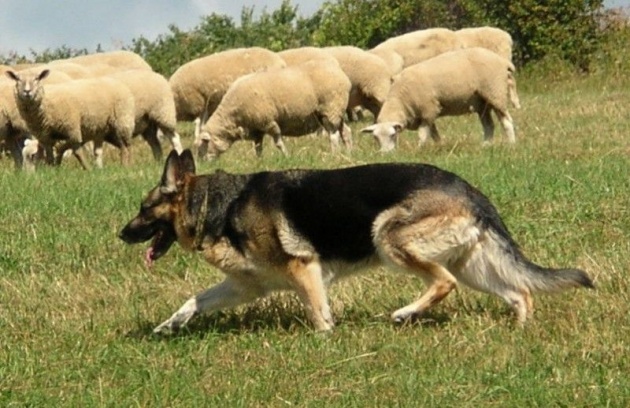The German Shepherd Dog (GSD).
The story of the German Shepherd Dog (GSD) has all the makings of a blockbuster film: a meteoric rise from obscurity to dizzying heights of achievement and fame, a tragic slide into misfortune and notoriety, and a courageous fight for redemption.
Sadly, this is no script and the true tale’s conclusion has yet to be written: by real people and real dogs who are still working toward a happy ending.
The story opens in late 19th-century Germany with the man who is credited with molding the original GSD, Max von Stephanitz. Taking the best dogs of several shepherd types, Stephanitz focused on creating the breed that is now described in the American Kennel Club (AKC) Standard as “a working animal with an incorruptible character combined with body and gait suitable for the arduous work that constitutes its primary purpose.” By breeding to strict standards of character, trainability, and physical ability, Stephanitz and his followers changed the humble sheep herding dogs into the Deutsche Schäferhunde (literally, German Sheepdog), a multi-talented working breed that proved itself in almost every field of endeavour open to dogs.
At the same time, the breed’s appearance became standardized to the German Shepherd we know today: a large, rugged dog with a wolfish head and erect ears and a thick double coat of medium length. The colour is usually reddish-brown with black markings, including a black mask and “saddle,” or sable, where the hairs are a lighter colour such as grey or gold, tipped in black. Solid black is also acceptable, but pale, washed-out colours are generally frowned upon.
In 1925, the GSD became the most popular breed in the US, due partly, no doubt, to the heroic exploits of the movie stars Rin Tin Tin and Strongheart, both classic GSDs in looks and onscreen personas (and both of whom have stars on Hollywood’s Walk of Fame). Since the 1920s, when the GSD began to dominate the popularity polls, the breed has only dropped out of the AKC Top Ten for a few years surrounding the Second World War, a time when anything “German” was unpatriotic. For the past fifty years, the GSD has been in the top four breeds, a standing unmatched by other breeds. German Shepherds have been the treasured companions of presidents (Franklin D. Roosevelt, Herbert Hoover, JFK), performers (Jake Gyllenhaal, Shania Twain), writers (Robert Ludlum, Maurice Sendak), and other celebrities (Gene Roddenberry, Picasso).
Unfortunately, demand for the GSD made it an obvious target for people who wanted to make an easy dollar by breeding and selling the popular pups and who had no knowledge of or interest in genetics, health, or temperament. Dogs poorly bred and raised began to give the breed a reputation for being hyperactive, vicious, and unhealthy. The stigma of hip dysplasia (an inherited condition where the hip joint fails and the dog becomes crippled) has become firmly affixed to the GSD’s reputation in the minds of the general public, although the disease actually occurs in many breeds, not just the German Shepherd.
Under siege from rampant overbreeding and image problems, the world of GSDs became riddled with controversy and various groups separated themselves from the mainstream to pursue their own ideas of the perfect dog. The Shiloh Shepherd was developed from the GSD in the past few decades as a “larger, sounder, and more traditional” dog, as was the King Shepherd. Allwhite German Shepherds, disqualified from AKC shows, maintain a staunch following and have their own registries and rescue associations. Breeders of working dogs often scorn show dogs and dogs of German bloodlines may be touted as the only “true” GSDs. Meanwhile, AKC and CKC breeders cling to their position as defenders of the “official” German Shepherd Dog in North America.
A lesser dog would have gone down under this assault, but the GSD has earned the love and loyalty of legions of passionate fans who will not abandon their breed, one which they are convinced is still the noblest all-around working dog in existence. Today, dedicated breeders continue with the task of eliminating genetic health problems and unstable temperaments to ensure that one of the most popular breeds in the world can still claim to be one of the finest.




